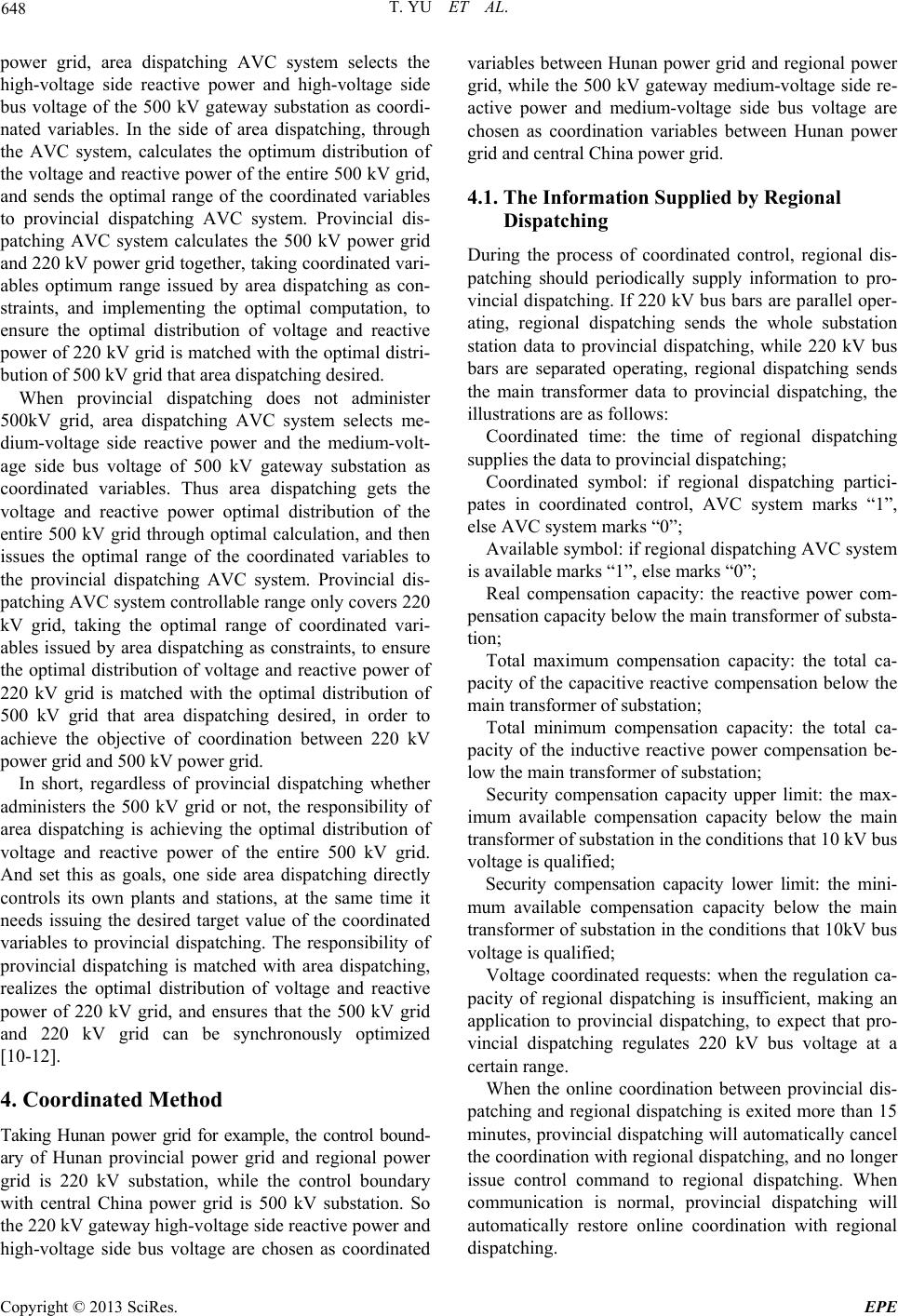
T. YU ET AL.
648
power grid, area dispatching AVC system selects the
high-voltage side reactive power and high-voltage side
bus voltage of the 500 kV gateway substation as coordi-
nated variables. In the side of area dispatching, through
the AVC system, calculates the optimum distribution of
the voltage and reactive power of the entire 500 kV grid,
and sends the optimal range of the coordinated variables
to provincial dispatching AVC system. Provincial dis-
patching AVC system calculates the 500 kV power grid
and 220 kV power grid together, taking coordinated vari-
ables optimum range issued by area dispatching as con-
straints, and implementing the optimal computation, to
ensure the optimal distribution of voltage and reactive
power of 220 kV grid is matched with the optimal distri-
bution of 500 k V grid that area dis pat chi n g d e sired.
When provincial dispatching does not administer
500kV grid, area dispatching AVC system selects me-
dium-voltage side reactive power and the medium-volt-
age side bus voltage of 500 kV gateway substation as
coordinated variables. Thus area dispatching gets the
voltage and reactive power optimal distribution of the
entire 500 kV grid through optimal calculation, and then
issues the optimal range of the coordinated variables to
the provincial dispatching AVC system. Provincial dis-
patching AVC system controllable range only covers 220
kV grid, taking the optimal range of coordinated vari-
ables issued by area dispatching as constraints, to ensure
the optimal distribution of voltage and reactive power of
220 kV grid is matched with the optimal distribution of
500 kV grid that area dispatching desired, in order to
achieve the objective of coordination between 220 kV
power grid and 500 kV power grid.
In short, regardless of provincial dispatching whether
administers the 500 kV grid or not, the responsibility of
area dispatching is achieving the optimal distribution of
voltage and reactive power of the entire 500 kV grid.
And set this as goals, one side area dispatching directly
controls its own plants and stations, at the same time it
needs issuing the desired target value of the coordinated
variables to provincial dispatching. The responsibility of
provincial dispatching is matched with area dispatching,
realizes the optimal distribution of voltage and reactive
power of 220 kV grid, and ensures that the 500 kV grid
and 220 kV grid can be synchronously optimized
[10-12].
4. Coordinated Method
Taking Hunan power grid for example, the control bound-
ary of Hunan provincial power grid and regional power
grid is 220 kV substation, while the control boundary
with central China power grid is 500 kV substation. So
the 220 kV gateway high-voltage side reactive power and
high-voltage side bus voltage are chosen as coordinated
variables between Hunan power grid and regional power
grid, while the 500 kV gateway medium-voltage side re-
active power and medium-voltage side bus voltage are
chosen as coordination variables between Hunan power
grid and central China power grid.
4.1. The Information Supplied by Regional
Dispatching
During the process of coordinated control, regional dis-
patching should periodically supply information to pro-
vincial dispatching. If 220 kV bus bars are parallel oper-
ating, regional dispatching sends the whole substation
station data to provincial dispatching, while 220 kV bus
bars are separated operating, regional dispatching sends
the main transformer data to provincial dispatching, the
illustrations are as follows:
Coordinated time: the time of regional dispatching
supplies the data to pro vincial dispatching;
Coordinated symbol: if regional dispatching partici-
pates in coordinated control, AVC system marks “1”,
else AVC system marks “0”;
Available symbol: if regional dispatching AVC system
is available marks “1”, else marks “0”;
Real compensation capacity: the reactive power com-
pensation capacity belo w the main transformer of su bsta-
tion;
Total maximum compensation capacity: the total ca-
pacity of the capacitive reactive compensation below the
main transformer of substation;
Total minimum compensation capacity: the total ca-
pacity of the inductive reactive power compensation be-
low the main transformer of substation;
Security compensation capacity upper limit: the max-
imum available compensation capacity below the main
transformer of substation in the conditions that 10 kV bus
voltage is qualified;
Security compensation capacity lower limit: the mini-
mum available compensation capacity below the main
transformer of substatio n in the conditions that 10kV bus
voltage is qualified;
Voltage coordinated requests: when the regulation ca-
pacity of regional dispatching is insufficient, making an
application to provincial dispatching, to expect that pro-
vincial dispatching regulates 220 kV bus voltage at a
certain range.
When the online coordination between provincial dis-
patching and regional dispatching is exited more than 15
minutes, provincial dispatch ing will automatically cancel
the coordination with regional dispatching, and no longer
issue control command to regional dispatching. When
communication is normal, provincial dispatching will
automatically restore online coordination with regional
dispatching.
Copyright © 2013 SciRes. EPE